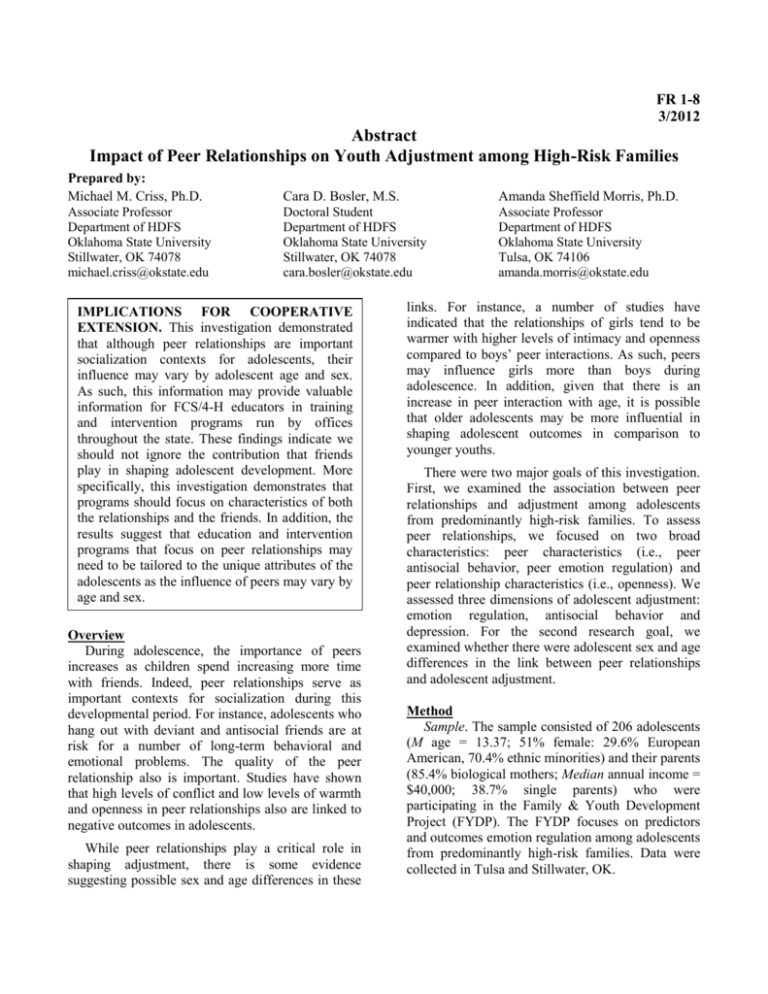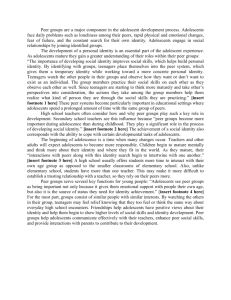Resource Update Abstract - Oklahoma State University
advertisement

FR 1-8 3/2012 Abstract Impact of Peer Relationships on Youth Adjustment among High-Risk Families Prepared by: Michael M. Criss, Ph.D. Associate Professor Department of HDFS Oklahoma State University Stillwater, OK 74078 michael.criss@okstate.edu Cara D. Bosler, M.S. Doctoral Student Department of HDFS Oklahoma State University Stillwater, OK 74078 cara.bosler@okstate.edu IMPLICATIONS FOR COOPERATIVE EXTENSION. This investigation demonstrated that although peer relationships are important socialization contexts for adolescents, their influence may vary by adolescent age and sex. As such, this information may provide valuable information for FCS/4-H educators in training and intervention programs run by offices throughout the state. These findings indicate we should not ignore the contribution that friends play in shaping adolescent development. More specifically, this investigation demonstrates that programs should focus on characteristics of both the relationships and the friends. In addition, the results suggest that education and intervention programs that focus on peer relationships may need to be tailored to the unique attributes of the adolescents as the influence of peers may vary by age and sex. Overview During adolescence, the importance of peers increases as children spend increasing more time with friends. Indeed, peer relationships serve as important contexts for socialization during this developmental period. For instance, adolescents who hang out with deviant and antisocial friends are at risk for a number of long-term behavioral and emotional problems. The quality of the peer relationship also is important. Studies have shown that high levels of conflict and low levels of warmth and openness in peer relationships also are linked to negative outcomes in adolescents. While peer relationships play a critical role in shaping adjustment, there is some evidence suggesting possible sex and age differences in these Amanda Sheffield Morris, Ph.D. Associate Professor Department of HDFS Oklahoma State University Tulsa, OK 74106 amanda.morris@okstate.edu links. For instance, a number of studies have indicated that the relationships of girls tend to be warmer with higher levels of intimacy and openness compared to boys’ peer interactions. As such, peers may influence girls more than boys during adolescence. In addition, given that there is an increase in peer interaction with age, it is possible that older adolescents may be more influential in shaping adolescent outcomes in comparison to younger youths. There were two major goals of this investigation. First, we examined the association between peer relationships and adjustment among adolescents from predominantly high-risk families. To assess peer relationships, we focused on two broad characteristics: peer characteristics (i.e., peer antisocial behavior, peer emotion regulation) and peer relationship characteristics (i.e., openness). We assessed three dimensions of adolescent adjustment: emotion regulation, antisocial behavior and depression. For the second research goal, we examined whether there were adolescent sex and age differences in the link between peer relationships and adolescent adjustment. Method Sample. The sample consisted of 206 adolescents (M age = 13.37; 51% female: 29.6% European American, 70.4% ethnic minorities) and their parents (85.4% biological mothers; Median annual income = $40,000; 38.7% single parents) who were participating in the Family & Youth Development Project (FYDP). The FYDP focuses on predictors and outcomes emotion regulation among adolescents from predominantly high-risk families. Data were collected in Tulsa and Stillwater, OK. Measures. Adolescents provided information on peer antisocial behavior, peer emotion regulation, peer-youth openness, and depression. Adolescent antisocial behavior and emotion regulation was based on youth and parent reports. Results Bivariate correlations indicated that high levels of peer antisocial behavior and low levels of peer emotion regulation were related to high levels of youth antisocial behavior and depression and low levels of youth emotion regulation. The findings also showed that high levels of peer openness were related to high levels of youth emotion regulation. While the peer factors were clearly correlated with different dimensions of adolescent adjustment, the results also indicated that these links varied by adolescent sex. For instance, peer openness was more strongly related to youth emotion regulation and depression for girls than boys. In contrast, the link between peer and youth antisocial behavior was stronger for boys than girls. In addition, there was evidence that associations were different in young and older youths. For example, peer emotion regulation and antisocial behavior were more strongly associated with youth antisocial behavior for older youths compared to younger adolescents. In contrast, peer openness was more strongly related to youth emotion regulation for younger adolescents compared to older youths. Discussion Overall, the results indicated that peer emotion regulation, peer antisocial behavior, and peer-youth openness all were significantly related to adolescent adjustment in expected directions. These findings provide evidence that peer relationships serve as critical contexts for socialization during adolescence. The exact process that this socialization occurs may vary from friend to friend. For instance, with youth spending increasing amount of time with friends, it is likely that adolescents model their behavior (good and bad) from observing their peers. In addition, having a warm and open relationship may facilitate the psychological intimacy that characterizes friendships during adolescence. Friendships also have dark sides as friends may introduce adolescents to delinquent-reinforcing situations and contexts, such as drug use or vandalism. Indeed, when adolescents are arrested, this often occurs in the presence of a friend. The findings also suggested that some aspects of peer relationships may be more salient for girls whereas other attributes may be more critical in shaping boys’ adjustment. For example, the level of openness and warmth in the relationships seems to be more critical for girls compared to boys. One possible reason for this is that open communication and psychological intimacy often are rated as being more prominent and crucial in girls’ relationships in comparison to boys’. In contrast, the findings demonstrated that the level of antisocial behavior among friends was more strongly associated with youth antisocial behavior for boys compared to girls. While antisocial behavior typically is significantly higher among boys compared to girls, it is possible that boys may be more heavily swayed by lure of antisocial friends. Indeed, discussion of antisocial activities (referred to as ‘deviant talk’ in the literature) tends to be higher in male relationships during childhood and adolescence. Overall, it is possible that the differences inherent to boys’ and girls’ friendships may provide unique socialization experiences (good and bad) for adolescents. Finally, the analyses demonstrated some age differences in the links between peer relationships and adolescent outcomes. Specifically, friend characteristics –emotion regulation and antisocial behavior – were more strongly related to adolescent adjustment for older youth compared to younger adolescents. One possible reason for this age difference may be that the friends of older youth may be more influential compared to young adolescents owing to the greater amount of time they spend together. In other words, the friends of older youth may be more salient role models because they spend so much more time together. While friend characteristics seemed to be more important among older adolescents, openness was more strongly linked to emotion regulation for younger youth. It may be that openness may be more crucial in the friendships of younger youth given the importance that psychological intimacy plays in their lives. With all of the developmental transformations that characterize early adolescence (e.g., puberty, transition into high school), it is not surprising that having open communication with one’s friends is especially important for this age group.







